instrument panel Peugeot 308 CC 2014 User Guide
[x] Cancel search | Manufacturer: PEUGEOT, Model Year: 2014, Model line: 308 CC, Model: Peugeot 308 CC 2014Pages: 268, PDF Size: 15.33 MB
Page 34 of 268
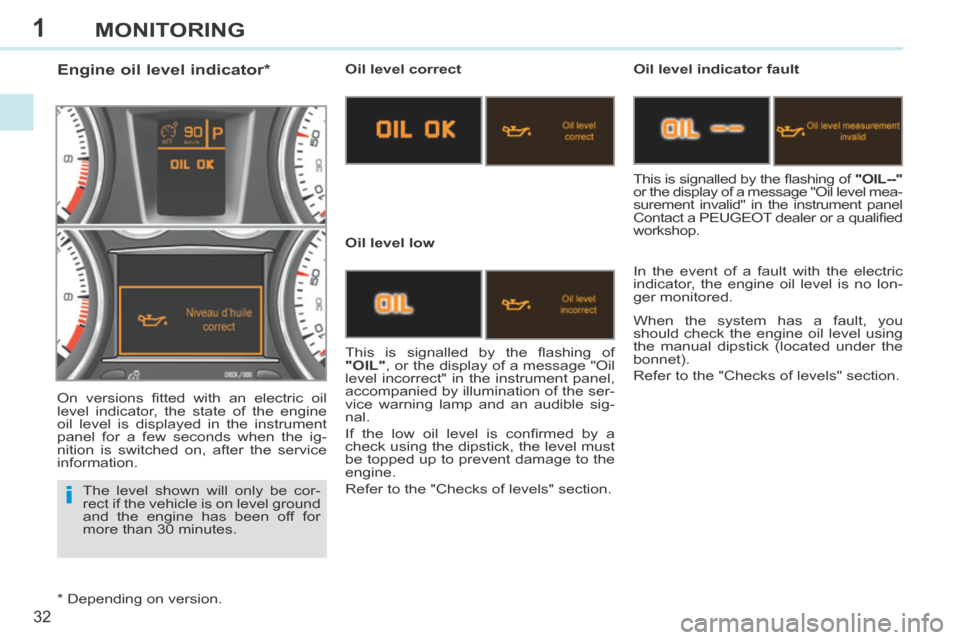
1
i
32
MONITORING
The level shown will only be cor-
rect if the vehicle is on level ground
and the engine has been off for
more than 30 minutes.
Engine oil level indicator * Oil level correct
Oil level low Oil level indicator fault
In the event of a fault with the electric
indicator, the engine oil level is no lon-
ger monitored.
This is signalled by the fl ashing of
"OIL" , or the display of a message "Oil
level incorrect" in the instrument panel,
accompanied by illumination of the ser-
vice warning lamp and an audible sig-
nal.
If the low oil level is confi rmed by a
check using the dipstick, the level must
be topped up to prevent damage to the
engine.
Refer to the "Checks of levels" section. This is signalled by the fl ashing of
"OIL--"
or the display of a message "Oil level mea-
surement invalid" in the instrument panel
Contact a PEUGEOT dealer or a qualifi ed
workshop.
When the system has a fault, you
should check the engine oil level using
the manual dipstick (located under the
bonnet).
Refer to the "Checks of levels" section.
On versions fi tted with an electric oil
level indicator, the state of the engine
oil level is displayed in the instrument
panel for a few seconds when the ig-
nition is switched on, after the service
information.
* Depending on version.
Page 35 of 268
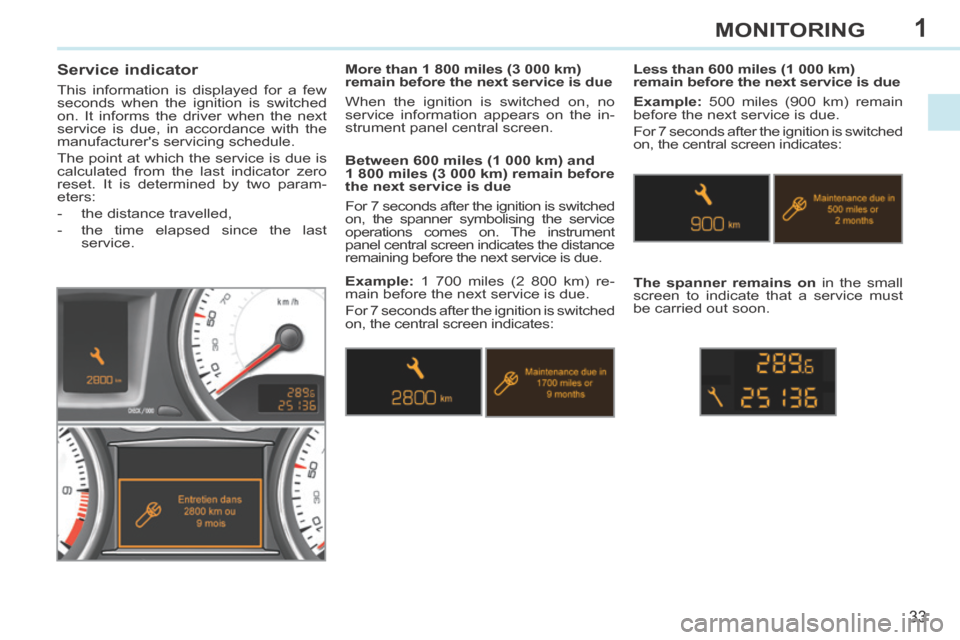
1
33
MONITORING
Service indicator
This information is displayed for a few
seconds when the ignition is switched
on. It informs the driver when the next
service is due, in accordance with the
manufacturer's servicing schedule.
The point at which the service is due is
calculated from the last indicator zero
reset. It is determined by two param-
eters:
- the distance travelled,
- the time elapsed since the last service. Between 600 miles (1 000 km) and
1 800 miles (3 000 km) remain before
the next service is due
For 7 seconds after the ignition is switched
on, the spanner symbolising the service
operations comes on. The instrument
panel central screen indicates the distance
remaining before the next service is due. Less than 600 miles (1 000 km)
remain before the next service is due
Example: 500 miles (900 km) remain
before the next service is due.
For 7 seconds after the ignition is switched
on, the central screen indicates:
The spanner remains on in the small
screen to indicate that a service must
be carried out soon.
More than 1 800 miles (3 000 km)
remain before the next service is due
When the ignition is switched on, no
service information appears on the in-
strument panel central screen.
Example: 1 700 miles (2 800 km) re-
main before the next service is due.
For 7 seconds after the ignition is switched
on, the central screen indicates:
Page 36 of 268
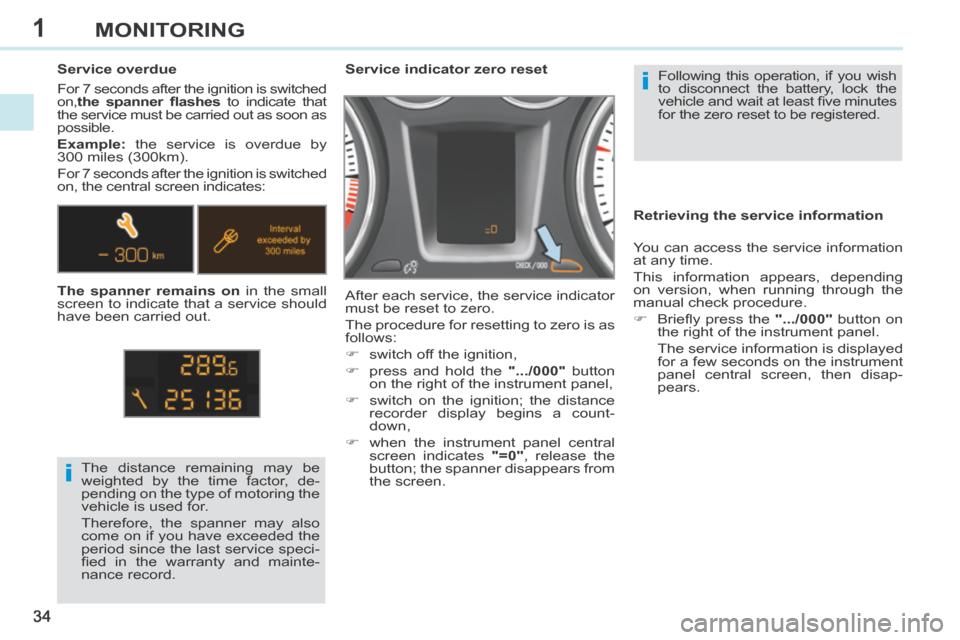
1
i
i
34
MONITORING
Following this operation, if you wish
to disconnect the battery, lock the
vehicle and wait at least fi ve minutes
for the zero reset to be registered.
Service indicator zero reset
After each service, the service indicator
must be reset to zero.
The procedure for resetting to zero is as
follows:
switch off the ignition,
press and hold the
".../000" button
on the right of the instrument panel,
switch on the ignition; the distance recorder display begins a count-
down,
when the instrument panel central screen indicates "=0" , release the
button; the spanner disappears from
the screen.
The distance remaining may be
weighted by the time factor, de-
pending on the type of motoring the
vehicle is used for.
Therefore, the spanner may also
come on if you have exceeded the
period since the last service speci-
fi ed in the warranty and mainte-
nance record.
Service overdue
For 7 seconds after the ignition is switched
on,
the spanner fl ashes to indicate that
the service must be carried out as soon as
possible.
Example: the service is overdue by
300 miles (300km).
For 7 seconds after the ignition is switched
on, the central screen indicates:
The spanner remains on in the small
screen to indicate that a service should
have been carried out. Retrieving the service information
You can access the service information
at any time.
This information appears, depending
on version, when running through the
manual check procedure.
Briefl y press the
".../000" button on
the right of the instrument panel.
The service information is displayed for a few seconds on the instrument
panel central screen, then disap-
pears.
Page 37 of 268
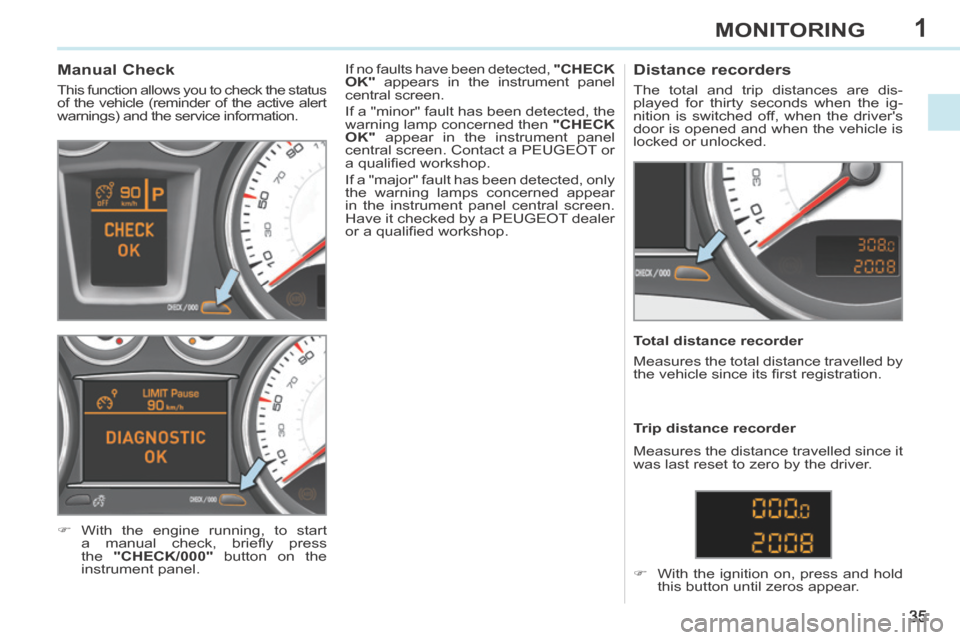
1
35
MONITORING
Manual Check
This function allows you to check the status
of the vehicle (reminder of the active alert
warnings) and the service information.
With the engine running, to start a manual check, briefl y press
the "CHECK/000" button on the
instrument panel. If no faults have been detected,
"CHECK
OK" appears in the instrument panel
central screen.
If a "minor" fault has been detected, the
warning lamp concerned then "CHECK
OK" appear in the instrument panel
central screen. Contact a PEUGEOT or
a qualifi ed workshop.
If a "major" fault has been detected, only
the warning lamps concerned appear
in the instrument panel central screen.
Have it checked by a PEUGEOT dealer
or a qualifi ed workshop.
Distance recorders
The total and trip distances are dis-
played for thirty seconds when the ig-
nition is switched off, when the driver's
door is opened and when the vehicle is
locked or unlocked.
Total distance recorder
Measures the total distance travelled by
the vehicle since its fi rst registration.
With the ignition on, press and hold this button until zeros appear.
Trip distance recorder
Measures the distance travelled since it
was last reset to zero by the driver.
Page 39 of 268
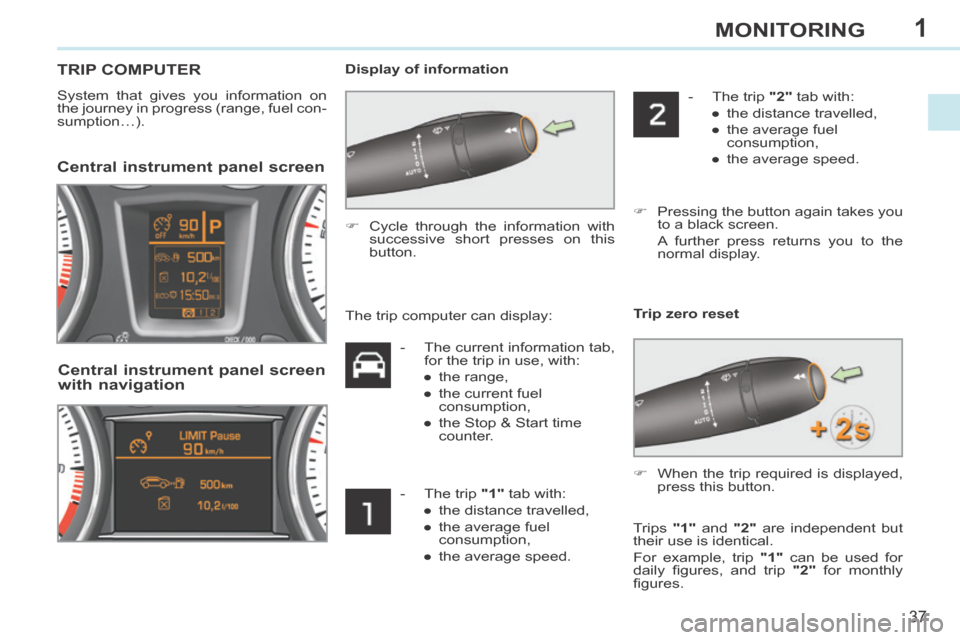
1
37
MONITORING
TRIP COMPUTER
System that gives you information on
the journey in progress (range, fuel con-
sumption…). Display of information
Central instrument panel screen
Cycle through the information with
successive short presses on this
button.
Central instrument panel screen
with navigation
Trip zero reset
- The current information tab, for the trip in use, with:
● the range,
● the current fuel consumption,
● the Stop & Start time counter.
- The trip "1" tab with: ● the distance travelled,
● the average fuel consumption,
● the average speed. - The trip "2" tab with:
● the distance travelled,
● the average fuel consumption,
● the average speed.
Pressing the button again takes you to a black screen.
A further press returns you to the normal display.
The trip computer can display:
When the trip required is displayed, press this button.
Trips "1" and "2" are independent but
their use is identical.
For example, trip "1" can be used for
daily fi gures, and trip "2" for monthly
fi gures.
Page 76 of 268
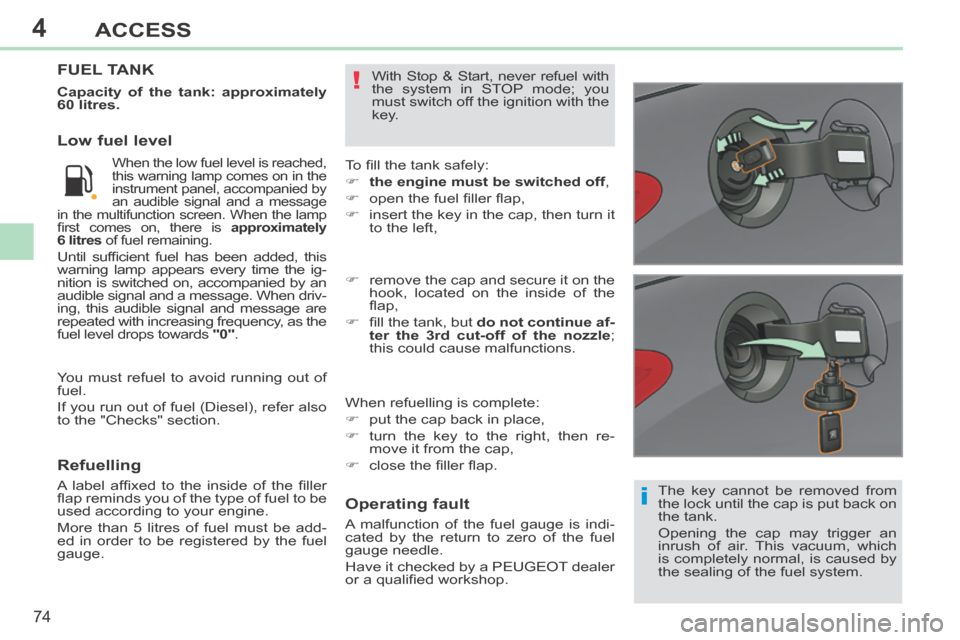
4
i
!
74
ACCESS
308CC_EN_CHAP04_OUVERTURES_ED01-2013
The key cannot be removed from
the lock until the cap is put back on
the tank.
Opening the cap may trigger an
inrush of air. This vacuum, which
is completely normal, is caused by
the sealing of the fuel system.
FUEL TANK
To fi ll the tank safely:
the engine must be switched off,
open the fuel fi ller fl ap,
insert the key in the cap, then turn it to the left,
When refuelling is complete:
put the cap back in place,
turn the key to the right, then re- move it from the cap,
close the fi ller fl ap. remove the cap and secure it on the hook, located on the inside of the
fl ap,
fi ll the tank, but do not continue af-
ter the 3rd cut-off of the nozzle ;
this could cause malfunctions.
Capacity of the tank: approximately
60 litres.
Refuelling
A label affi xed to the inside of the fi ller
fl ap reminds you of the type of fuel to be
used according to your engine.
More than 5 litres of fuel must be add-
ed in order to be registered by the fuel
gauge.
When the low fuel level is reached,
this warning lamp comes on in the
instrument panel, accompanied by
an audible signal and a message
in the multifunction screen. When the lamp
fi rst comes on, there is approximately
6 litres of fuel remaining.
Until suffi cient fuel has been added, this
warning lamp appears every time the ig-
nition is switched on, accompanied by an
audible signal and a message. When driv-
ing, this audible signal and message are
repeated with increasing frequency, as the
fuel level drops towards "0" .
Operating fault
A malfunction of the fuel gauge is indi-
cated by the return to zero of the fuel
gauge needle.
Have it checked by a PEUGEOT dealer
or a qualifi ed workshop. With Stop & Start, never refuel with
the system in STOP mode; you
must switch off the ignition with the
key.
Low fuel level
You must refuel to avoid running out of
fuel.
If you run out of fuel (Diesel), refer also
to the "Checks" section.
Page 78 of 268
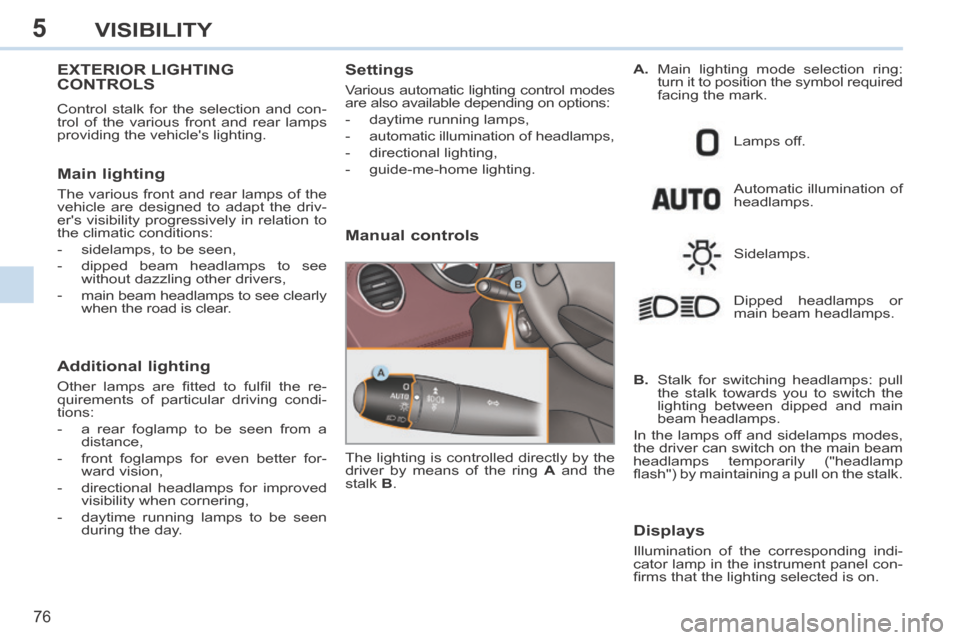
5
76
VISIBILITY
EXTERIOR LIGHTING CONTROLS
Control stalk for the selection and con-
trol of the various front and rear lamps
providing the vehicle's lighting.
Main lighting
The various front and rear lamps of the
vehicle are designed to adapt the driv-
er's visibility progressively in relation to
the climatic conditions:
- sidelamps, to be seen,
- dipped beam headlamps to see without dazzling other drivers,
-
main beam headlamps to see clearly
when the road is clear.
Additional lighting
Other lamps are fi tted to fulfi l the re-
quirements of particular driving condi-
tions:
- a rear foglamp to be seen from a distance,
- front foglamps for even better for- ward vision,
- directional headlamps for improved visibility when cornering,
- daytime running lamps to be seen during the day.
Settings
Various automatic lighting control modes
are also available depending on options:
- daytime running lamps,
- automatic illumination of headlamps,
- directional lighting,
- guide-me-home lighting.
Manual controls
Automatic illumination of
headlamps.
The lighting is controlled directly by the
driver by means of the ring A and the
stalk B . Lamps off.
Sidelamps.
B. Stalk for switching headlamps: pull the stalk towards you to switch the
lighting between dipped and main
beam headlamps.
In the lamps off and sidelamps modes,
the driver can switch on the main beam
headlamps temporarily ("headlamp
fl ash") by maintaining a pull on the stalk. Dipped headlamps or
main beam headlamps.
Displays
Illumination of the corresponding indi-
cator lamp in the instrument panel con-
fi rms that the lighting selected is on. A.
Main lighting mode selection ring:
turn it to position the symbol required
facing the mark.
Page 80 of 268
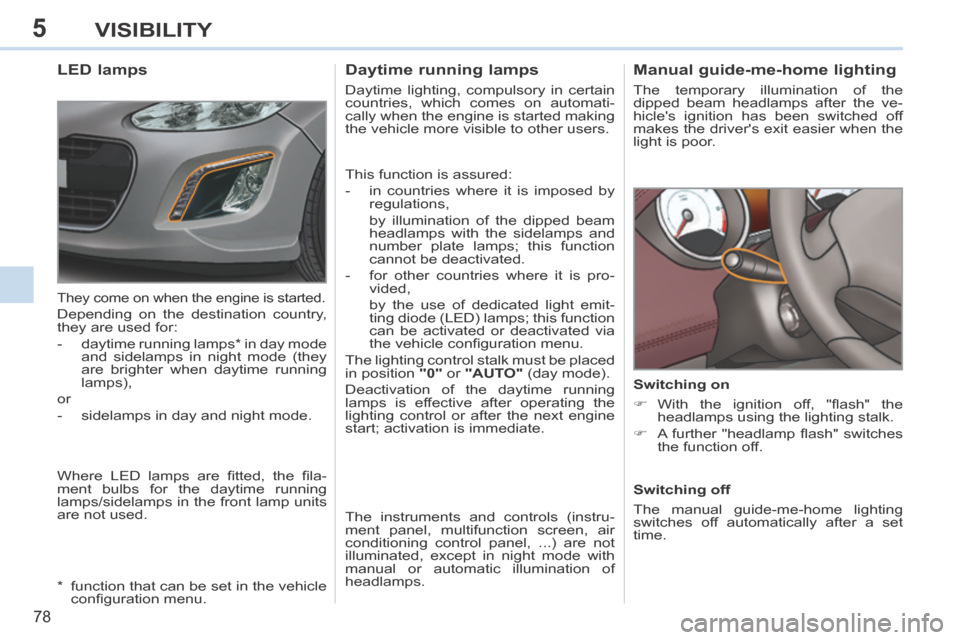
5
78
VISIBILITY
Manual guide-me-home lighting
The temporary illumination of the
dipped beam headlamps after the ve-
hicle's ignition has been switched off
makes the driver's exit easier when the
light is poor.
Switching on
With the ignition off, "fl ash" the headlamps using the lighting stalk.
A further "headlamp fl ash" switches the function off.
Switching off
The manual guide-me-home lighting
switches off automatically after a set
time.
Daytime running lamps
Daytime lighting, compulsory in certain
countries, which comes on automati-
cally when the engine is started making
the vehicle more visible to other users.
This function is assured:
- in countries where it is imposed by regulations,
by illumination of the dipped beam headlamps with the sidelamps and
number plate lamps; this function
cannot be deactivated.
- for other countries where it is pro- vided,
by the use of dedicated light emit- ting diode (LED) lamps; this function
can be activated or deactivated via
the vehicle confi guration menu.
The lighting control stalk must be placed
in position "0" or "AUTO" (day mode).
Deactivation of the daytime running
lamps is effective after operating the
lighting control or after the next engine
start; activation is immediate.
The instruments and controls (instru-
ment panel, multifunction screen, air
conditioning control panel, ...) are not
illuminated, except in night mode with
manual or automatic illumination of
headlamps.
LED lamps
Where LED lamps are fi tted, the fi la-
ment bulbs for the daytime running
lamps/sidelamps in the front lamp units
are not used.
They come on when the engine is started.
Depending on the destination country,
they are used for:
- daytime running lamps * in day mode and sidelamps in night mode (they
are brighter when daytime running
lamps),
or
- sidelamps in day and night mode.
* function that can be set in the vehicle confi guration menu.
Page 81 of 268
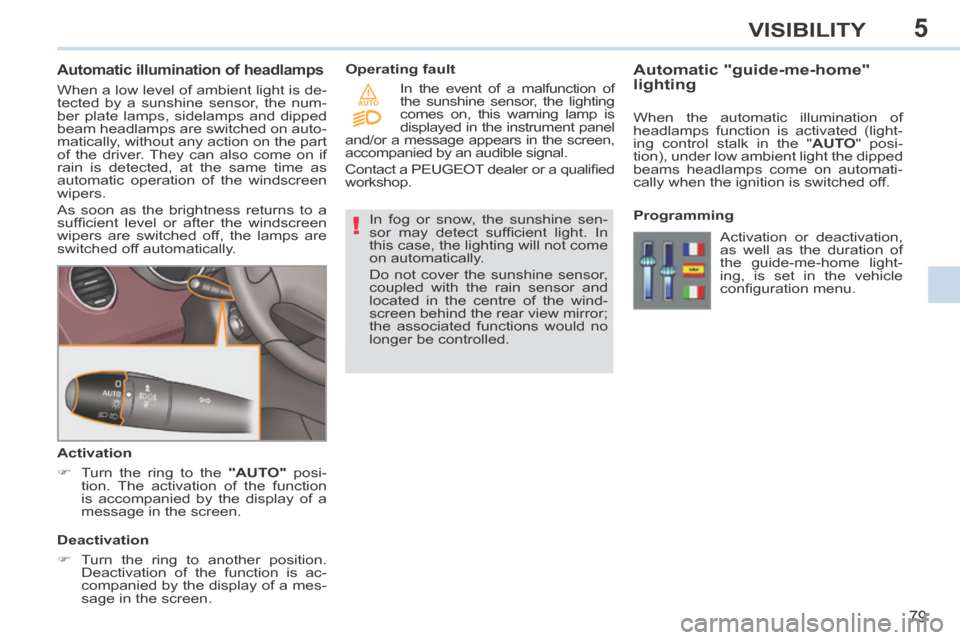
5
!
AUTO
79
VISIBILITY
Automatic illumination of headlamps
When a low level of ambient light is de-
tected by a sunshine sensor, the num-
ber plate lamps, sidelamps and dipped
beam headlamps are switched on auto-
matically, without any action on the part
of the driver. They can also come on if
rain is detected, at the same time as
automatic operation of the windscreen
wipers.
As soon as the brightness returns to a
suffi cient level or after the windscreen
wipers are switched off, the lamps are
switched off automatically.
Activation
Turn the ring to the "AUTO" posi-
tion. The activation of the function
is accompanied by the display of a
message in the screen.
Deactivation
Turn the ring to another position. Deactivation of the function is ac-
companied by the display of a mes-
sage in the screen. In fog or snow, the sunshine sen-
sor may detect suffi cient light. In
this case, the lighting will not come
on automatically.
Do not cover the sunshine sensor,
coupled with the rain sensor and
located in the centre of the wind-
screen behind the rear view mirror;
the associated functions would no
longer be controlled.
Operating fault
Automatic "guide-me-home"
lighting
When the automatic illumination of
headlamps function is activated (light-
ing control stalk in the "
AUTO " posi-
tion), under low ambient light the dipped
beams headlamps come on automati-
cally when the ignition is switched off.
In the event of a malfunction of
the sunshine sensor, the lighting
comes on, this warning lamp is
displayed in the instrument panel
and/or a message appears in the screen,
accompanied by an audible signal.
Contact a PEUGEOT dealer or a qualifi ed
workshop.
Programming Activation or deactivation,
as well as the duration of
the guide-me-home light-
ing, is set in the vehicle
confi guration menu.
Page 82 of 268
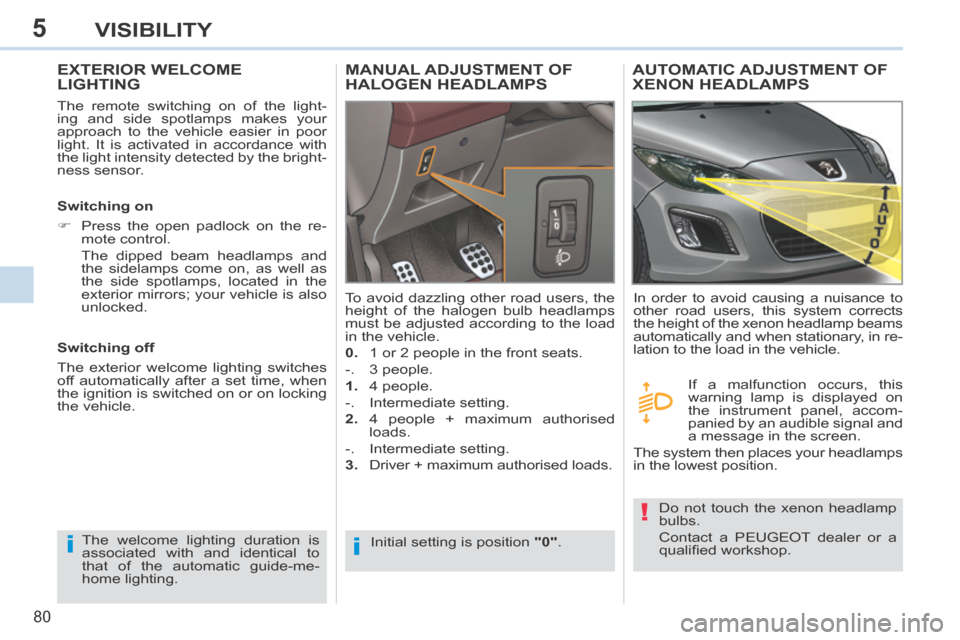
5
ii
!
80
VISIBILITY
EXTERIOR WELCOME LIGHTING
The remote switching on of the light-
ing and side spotlamps makes your
approach to the vehicle easier in poor
light. It is activated in accordance with
the light intensity detected by the bright-
ness sensor.
Switching on
Press the open padlock on the re-mote control.
The dipped beam headlamps and the sidelamps come on, as well as
the side spotlamps, located in the
exterior mirrors; your vehicle is also
unlocked.
The welcome lighting duration is
associated with and identical to
that of the automatic guide-me-
home lighting.
MANUAL ADJUSTMENT OF HALOGEN HEADLAMPS
Initial setting is position "0" .
To avoid dazzling other road users, the
height of the halogen bulb headlamps
must be adjusted according to the load
in the vehicle.
0.
1 or 2 people in the front seats.
-. 3 people.
1. 4 people.
-. Intermediate setting.
2. 4 people + maximum authorised
loads.
-. Intermediate setting.
3. Driver + maximum authorised loads.
Switching off
The exterior welcome lighting switches
off automatically after a set time, when
the ignition is switched on or on locking
the vehicle.
AUTOMATIC ADJUSTMENT OF XENON HEADLAMPS
Do not touch the xenon headlamp
bulbs.
Contact a PEUGEOT dealer or a
qualifi ed workshop.
In order to avoid causing a nuisance to
other road users, this system corrects
the height of the xenon headlamp beams
automatically and when stationary, in re-
lation to the load in the vehicle.
If a malfunction occurs, this
warning lamp is displayed on
the instrument panel, accom-
panied by an audible signal and
a message in the screen.
The system then places your headlamps
in the lowest position.